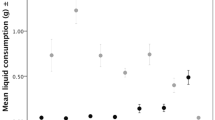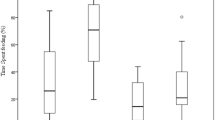Abstract
Nectarivorous and frugivorous birds have been found to select their diet according to sugar type and concentration. Consequently, many studies of sugar preference have been conducted on various avian species. Common Mynas, Sturnus tristis, previously known as Acridotheres tristis, are considered amongst the 100 worst invasive species worldwide and damage fruit crops in some countries. However, their sugar preferences have never been studied. Therefore, we investigated the effect of sugar type and concentration on sugar preference and assimilation efficiency in Common Mynas (n = 7). Birds were given pairwise choice tests of sugars (fructose, sucrose and glucose) of 5 g/ml (5%) to test sugar preference. Common Mynas showed preference for glucose over fructose and sucrose. To determine at which concentrations they prefer glucose, they were offered three different concentrations of glucose (5, 10 and 25%). They showed distinct preference for the 10% concentration of glucose in comparison with 5% and 25% glucose nectars. The birds maintained body mass in the respective experimental trials thus showed sufficient energy intake. Common Mynas failed to digest and absorb sucrose, but fructose and glucose were digested and assimilated efficiently for all concentrations. Results of this study showed that Common Mynas prefer glucose, especially at ~ 10% concentration. Species distribution is determined by food resources, and these results on sugar type and preference of Common Mynas might contribute to preventing or managing their spread in South Africa.
Zusammenfassung
Zuckerpräferenz beim invasiven Heuschreckenstar ( Sturnus tristis )
Von Vögeln, die sich von Nektar und Früchten ernähren, ist bekannt, dass sie ihre Nahrung nach Art und Konzentration des darin enthaltenen Zuckers auswählen. Für viele Vogelarten liegen bereits entsprechende Untersuchungen zur Zuckerpräferenz vor. Der Heuschreckenstar (Sturnus tristis, früher bekannt als Acridotheres tristis) gilt als eine der „100 schlimmsten invasiven Arten“ weltweit und schädigt Obstplantagen in einigen Ländern. Seine Zuckerpräferenz ist jedoch bislang nie untersucht worden. Deshalb ermittelten wir für Heuschreckenstare (n=7) die Effekte von Zuckertyp und -konzentration auf ihre Zuckerpräferenz und –aufnahmeeffizienz. Den Vögeln wurde die Wahl zwischen Fruktose, Sukrose und Glukose von 5g/ml (5%) gegeben um zu sehen, welchen Zucker sie bevorzugten. Die Heuschreckenstare zogen Glukose der Fruktose und Sukrose vor. Um herauszufinden, bei welcher Konzentration sie Glukose vorzogen, wurde ihnen diese in drei verschiedenen Konzentrationen angeboten: 5%, 10% und 25%, und sie zeigten eine ganz klare Präferenz für die 10%ige Konzentration. In allen drei Varianten dieses Versuchs konnten die Vögel ihre Körpermasse halten, was zeigt, dass ihre Energieaufnahme jeweils ausreichend war. Die Heuschreckenstare waren nicht in der Lage, Sukrose zu verdauen, aber Fruktose und Glukose konnten in allen Konzentrationen effizient verdaut werden. Die Ergebnisse dieser Untersuchung zeigen, dass Heuschreckenstare Glukose bevorzugen, speziell bei Konzentrationen um die 10%. Die Verbreitung einer Art wird vom Vorhandensein von ausreichend Nahrung bestimmt, und unsere Ergebnisse zur Zuckerpräferenz von Heuschreckenstaren könnten einen Beitrag zur Verhinderung oder jedenfalls dem Management ihrer Ausbreitung in Südafrika leisten.



Similar content being viewed by others
References
Avery ML, Schreiber CL, Decker DG (1999) Fruit sugar preferences of House Finches. Wilson Bull 111:84–88
Ayala-Berdon J, Rodríguez-Peña N, Leal CG, Stoner KE, Schondube JE (2013) Sugar gustatory thresholds and sugar selection in two species of Neotropical nectar-eating bats. Comp Biochem Physiol 164:307–313
Bae H, Yun SK, Yoon IK, Nam EY, Kwon JH, Jun JH (2014) Assessment of organic acid and sugar composition in apricot, plumcot, plum, and peach during fruit development. J Appl Bot Food Qual 87:24–29
Baker HG, Baker I (1982) Chemical constituents of nectar in relation to pollination mechanisms and phylogeny. In: Nitecki MH (ed) Biochemical aspects of evolutionary biology. University of Chicago Press, Chicago, pp 131–171
Baker AJ, Moeed A (1987) Rapid genetic differentiation and founder effect in colonizing populations of Common Mynas (Acridotheres tristis). Evolution 41:525–538
Bizaaré L, Coetzer TH, Downs CT (2012) Disaccharidase presence and activities in a range of southern African frugivores. Ostrich 83:165–168
Brooks M (2013) Biodiversity monitoring everywhere. http://mybirdpatch.adu.org.za/news.php?id=3948. Accessed 4 May 2016
Brown M, Downs CT, Johnson SD (2010a) Concentration-dependent sugar preferences of the Malachite Sunbird (Nectarinia famosa). Auk 127:151–155
Brown M, Downs CT, Johnson SD (2010b) Sugar preferences and digestive efficiency in an opportunistic avian nectarivore, the Dark-capped Bulbul Pycnonotus tricolor. J Ornith 151:637–643
Brown M, Downs CT, Johnson SD (2010c) Sugar preferences of a generalist nonpasserine flower visitor, the African Speckled Mousebird (Colius striatus). Auk 127:781–786
Brown M, Downs CT, Johnson SD (2012) African Red-winged Starlings prefer hexose sugar solutions, but do not like them too sweet. J Ornith 153:265–272
Bruwer J (2003) South African wine routes: some perspectives on the wine tourism industry’s structural dimensions and wine tourism product. Tourism Manage 24:423–435
Dean W (2000) Alien birds in southern Africa: what factors determine success? S Afr J Sci 96:9–14
Downs CT (1997) Sugar preference and apparent sugar assimilation in the Red Lory. Aust J Zool 45:613–619
Downs CT, Perrin M (1996) Sugar preferences of some southern African nectarivorous birds. Ibis 138:455–459
Downs CT, Mqokeli B, Singh P (2012) Sugar assimilation and digestive efficiency in Wahlberg’s Epauletted Fruit Bat (Epomophorus wahlbergi). Comp Biochem Physiol A 161:344–348
Gartrell BD (2000) The nutritional, morphologic, and physiologic bases of nectarivory in Australian birds. J Avian Med Surgery 14:85–94
Gatica CD, González SP, Vásquez RA, Sabat P (2006) On the relationship between sugar digestion and diet preference in two Chilean avian species belonging to the Muscicapoidea superfamily. Rev Chil Hist Nat J 79:287–294
Griffin AS, Boyce HM (2009) Indian Mynahs, Acridotheres tristis, learn about dangerous places by observing the fate of others. Anim Behav 78:79–84
Gurevitch J, Padilla DK (2004) Are invasive species a major cause of extinctions? Trees 19:470–474
Haythorpe KM, Burke D, Sulikowski D (2014) The native versus alien dichotomy: relative impact of native Noisy Miners and introduced Common Mynas. Biol Invasions 16:1659–1674
Heger T, Trepl L (2003) Predicting biological invasions. Biol Invasions 5:313–321
Holzapfel C, Levin N, Hatzofe O, Kark S (2006) Colonisation of the Middle East by the invasive Common Myna Acridotheres tristis L., with special reference to Israel. Sandgrouse 28:44
Johnson SD, Nicolson SW (2008) Evolutionary associations between nectar properties and specificity in bird pollination systems. Biol Lett 4:49–52
Kaplan D, Kaplinsky R (1999) Trade and industrial policy on an uneven playing field: the case of the deciduous fruit canning industry in South Africa. World Dev 27:1787–1801
Lane SJ (1997) Preferences and apparent digestibilities of sugars by fruit damaging birds in Japan. Ann Appl Biol 130:361–370
Larson DL (1996) Seed dispersal by specialist versus generalist foragers: the plant’s perspective. Oikos 76:113–120
López-Calleja MV, Bozinovic F, Martínez del Rio C (1997) Effects of sugar concentration on hummingbird feeding and energy use. Comp Biochem Physiol A 118:1291–1299
Lotz C, Nicolson S (1996) Sugar preferences of a nectarivorus passerine bird, the Lesser Double-collared Sunbird (Nectarinia chalybea). Funct Ecol 10:360–365
Lotz CN, Schondube JE (2006) Sugar preferences in nectar- and fruit-eating birds: behavioral patterns and physiological causes. Biotropica 38:3–15
Lowe KA, Taylor CE, Major RE (2011) Do Common Mynas significantly compete with native birds in urban environments? J Ornith 152:909–921
Martínez del Rio C, Schondube JE, McWhorter TJ, Herrera LG (2001) Intake responses in nectar feeding birds: digestive and metabolic causes, osmoregulatory consequences, and coevolutionary effects. Am Zool 41:902–915
Mata A, Bosque C (2004) Sugar preferences, absorption efficiency and water influx in a Neotropical nectarivorous passerine, the Bananaquit (Coereba flaveola). Comp Biochem Physiol A 139:395–404
Nicolson SW, Fleming PA (2014) Drinking problems on a ‘simple’ diet: physiological convergence in nectar-feeding birds. J Exp Biol 217:1015–1023
Nzama SN, Downs CT, Brown M (2010) Seasonal variation in the metabolism-temperature relation of House Sparrows (Passer domesticus) in KwaZulu-Natal, South Africa. J Therm Biol 35:100–104
Odendaal T, Brown M, Downs CT, Johnson S (2010) Sugar preferences and digestive efficiency of the Village Weaver: a generalist avian pollinator of African plants. J Exp Biol 213:2531–2535
Peacock DS, Van Rensburg BJ, Robertson MP (2007) The distribution and spread of the invasive alien Common Myna, Acridotheres tristis L. (Aves: Sturnidae), in southern Africa. S Afr J Sci 103:465–473
Pimentel D, McNair S, Janecka J, Wightman J, Simmonds C, O’Connell C, Wong E, Russel L, Zern J, Aquino T (2001) Economic and environmental threats of alien plant, animal, and microbe invasions. Agric Ecosys Environ 84:1–20
Richardson DM, Pyšek P, Rejmánek M, Barbour MG, Panetta FD, West CJ (2000) Naturalization and invasion of alien plants: concepts and definitions. Divers Distrib 6:93–107
Schaefer HM, Schmidt V, Bairlein F (2003) Discrimination abilities for nutrients: which difference matters for choosy birds and why? Anim Behav 65:531–541
Schondube JE, Martínez Del Rio M (2003) Concentration-dependent sugar preferences in nectar-feeding birds: mechanisms and consequences. Funct Ecol 17:445–453
Symes CT, Yoganand K (2013) Schotia brachypetala–a nectar cornucopia for birds. Bull Afr Bird Club 20:39–44
Thabethe V, Thompson LJ, Hart LA, Brown M, Downs CT (2013) Seasonal effects on the thermoregulation of invasive Rose-ringed Parakeets (Psittacula krameri). J Therm Biol 38:553–559
Wang SY, Chen CT, Wang CY (2009) The influence of light and maturity on fruit quality and flavonoid content of red raspberries. Food Chem 112:676–684
Wellmann A, Downs CT (2009) Sugar preferences and digestion by Cape White-eyes, Zosterops virens, fed artificial fruit diets. Afr Zool 44:106–116
Wilson A-L, Downs CT (2011a) Digestive efficiency of Knysna and Purple-crested Turacos fed varying concentrations of equicaloric and equimolar artificial fruit. J Exp Biol 214:607–612
Wilson A-L, Downs CT (2011b) Food preferences of Knysna and Purple-crested Turacos fed varying concentrations of equicaloric and equimolar artificial fruit. J Exp Biol 214:613–618
Witteveen M, Brown M (2014) Sugar type and concentration preference of the Cape White-eye, Zosterops virens. Afr Zool 49:22–29
Zungu MM, Downs CT (2016) Digestive efficiencies of Cape white-eyes (Zosterops virens), Red-winged Starlings (Onychognathus morio) and Speckled Mousebirds (Colius striatus) on equicaloric glucose and sucrose artificial fruit diets. Comp Biochem Physiol A 199:28–37
Acknowledgements
Special thanks are due to the University of KwaZulu-Natal, the National Research Foundation, and the Centre of Excellence for Invasion Biology, University of Stellenbosch, for research funding. We thank T. Mjwara for helping in the animal house, and E. Ally and P. Singh for helping in the field. We are grateful to B. Jilajila for his support and advice. We are grateful for the constructive comments of the reviewers.
Author information
Authors and Affiliations
Corresponding author
Ethics declarations
Conflict of interest
The authors declare they have no competing interests.
Ethical standards
All applicable international, national, and/or institutional guidelines for the care and use of animals were followed. We had permission for the study from the University of KwaZulu-Natal Animal Research Ethics Committee.
Additional information
Communicated by L. Fusani.
Rights and permissions
About this article
Cite this article
Gumede, S.T., Downs, C.T. Sugar preference of invasive Common Mynas (Sturnus tristis). J Ornithol 160, 71–78 (2019). https://doi.org/10.1007/s10336-018-1600-x
Received:
Revised:
Accepted:
Published:
Issue Date:
DOI: https://doi.org/10.1007/s10336-018-1600-x




